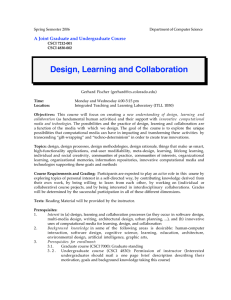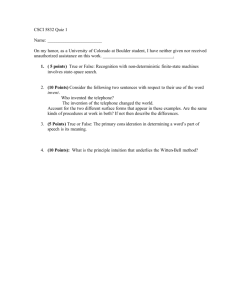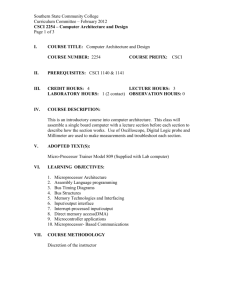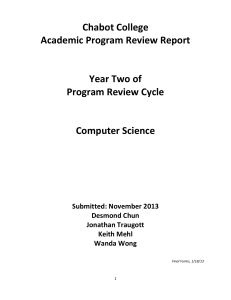Chabot College Program Review Report 2015 ‐2016
advertisement
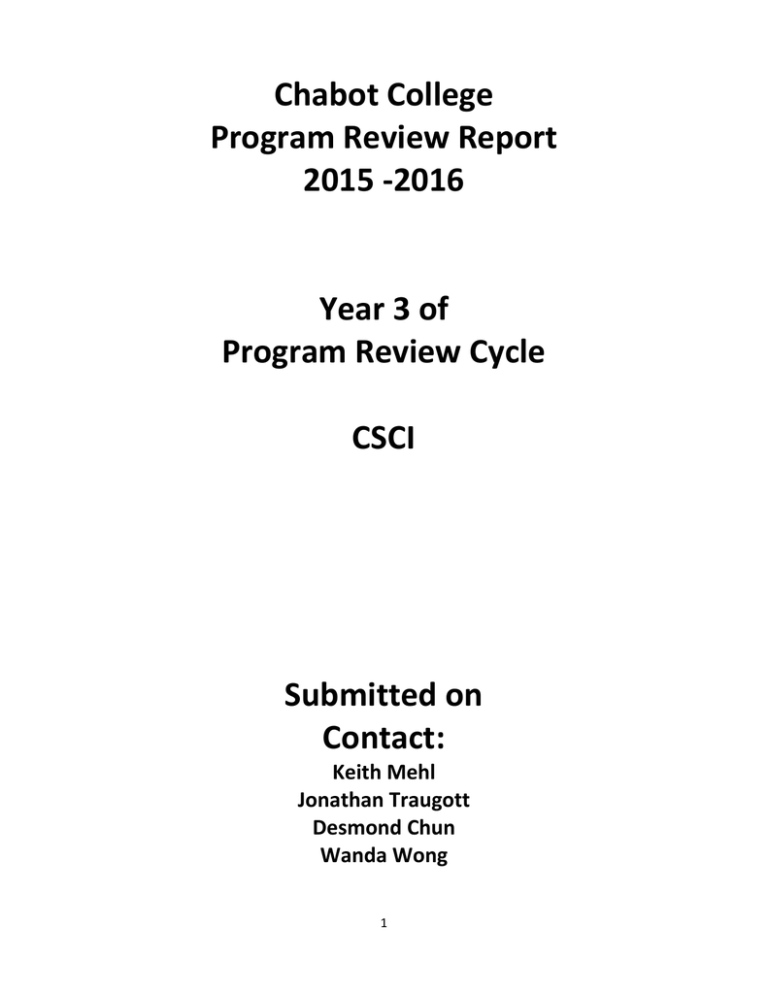
Chabot College Program Review Report 2015 ‐2016 Year 3 of Program Review Cycle CSCI Submitted on Contact: Keith Mehl Jonathan Traugott Desmond Chun Wanda Wong 1 Appendix B2: “Closing the Loop” Course‐Level Assessment Reflections. Course CSCI 20 Semester assessment data gathered Spring 2013 Number of sections offered in the semester 1 Number of sections assessed 1 Percentage of sections assessed 100% Semester held “Closing the Loop” discussion Spring 2014 Faculty members involved in “Closing the Loop” discussion D. Chun, K. Mehl, J.Traugott, W. Wong Form Instructions: Complete a separate Appendix B2 form for each Course‐Level assessment reported in this Program Review. These courses should be listed in Appendix B1: Student Learning Outcomes Assessment Reporting Schedule. Part I: CLO Data Reporting. For each CLO, obtain Class Achievement data in aggregate for all sections assessed in eLumen. Part II: CLO Reflections. Based on student success reported in Part I, reflect on the individual CLO. Part III: Course Reflection. In reviewing all the CLOs and your findings, reflect on the course as a whole. PART I: COURSE‐LEVEL OUTCOMES – DATA RESULTS CONSIDER THE COURSE‐LEVEL OUTCOMES INDIVIDUALLY (THE NUMBER OF CLOS WILL DIFFER BY COURSE) (CLO) 1:Write recursive methods (CLO) 2:Explain how recursion is implemented (CLO) 3:Define a stack ADT and implement a stack ADT as array (or vector) and as a linked list (CLO) 4:manipulate arrays using pointer notation Actual Scores** (eLumen data) Defined Target Scores* (CLO Goal) 75% 93% 75% 88% 75% 92% 75% 100% If more CLOs are listed for the course, add another row to the table. * Defined Target Scores:What scores in eLumen from your students would indicate success for this CLO? (Example: 75% of the class scored either 3 or 4) **Actual scores: What is the actual percent of students that meet defined target based on the eLumen data collected in this assessment cycle? 2 PART II: COURSE‐ LEVEL OUTCOME REFLECTIONS A. COURSE‐LEVEL OUTCOME (CLO) 1: 1. How do your current scores match with your above target for student success in this course level outcome? 93% of students in CSCI 20 were able to master recursion. This is well above our target of 75% 2. Reflection: Based on the data gathered, and considering your teaching experiences and your discussions with other faculty, what reflections and insights do you have? Students struggle with recursion so we introduce the topic in CSCI 15 and reinforce it in CSCI 20. The strategy appears to be successful. B. COURSE‐LEVEL OUTCOME (CLO) 2: 1. How do your current scores match with your above target for student success in this course level outcome? Understanding the mechanism for recursion we achieved by most students. 2. Reflection: Based on the data gathered, and considering your teaching experiences and your discussions with other faculty, what reflections and insights do you have? The overall score of 88% is a bit lower than for CLO 1, which is understandable since the mechanism for recursion hard to grasp without an understanding of lower level aspects of program execution. 3 C. COURSE‐LEVEL OUTCOME (CLO) 3: 1. How do your current scores match with your above target for student success in this course level outcome? 92% of students were able to understand and use stacks. This is well above our target of 75% 2. Reflection: Based on the data gathered, and considering your teaching experiences and your discussions with other faculty, what reflections and insights do you have? Stacks are one of the core data structures so it’s essential that students grasp the concept in order to successfully complete the CSCI 20. Ideally the overall score should be 100%, so we may need to put more emphasis on stacks or possibly introduce the concept in CSCI 15. D. COURSE‐LEVEL OUTCOME (CLO) 4: 1. How do your current scores match with your above target for student success in this course level outcome? 100% of students were able to manipulate arrays using pointer notation. 2. Reflection: Based on the data gathered, and considering your teaching experiences and your discussions with other faculty, what reflections and insights do you have? Pointers are an essential tool for implementing data structures in C++ . So we introduce the concept in CSCI 15 and reinforce it in CSCI 20. E. COURSE‐LEVEL OUTCOME (CLO) 5: ADD IF NEEDED. 4 PART III: COURSE REFLECTIONS AND FUTURE PLANS 1. What changes were made to your course based on the previous assessment cycle, the prior Closing the Loop reflections and other faculty discussions? More challenging programming exercises were introduced in CSCI 15 in order to lift programming skills to the level required for CSCI 20. Some instructors are using MyProgrammingLab so students can work through a large number of key exercises and get immediate feedback from the computer. All instructors teaching CSCI 15 now cover topics that prepare for CSCI. These include: linked lists, class templates, dynamic binding, overloading operators (including the assignment operator when classes include dynamically allocated data) and dynamically allocated two dimensional arrays. 2. Based on the current assessment and reflections, what course‐level and programmatic strengths have the assessment reflections revealed? What actions has your discipline determined might be taken as a result of your reflections, discussions, and insights? CSCI 15 is considered an especially challenging course and that’s as it should be. Unless the student has the dedication and ability to master higher‐lever concepts and programming skills, they will not succeed in CSCI 20 or beyond. We are currently impacted in CSCI 15 with 53 students in the current section whose cap is just 35. Therefore we request an additional section of CSCI 15 to be offered in spring semester. 3. What is the nature of the planned actions (please check all that apply)? Curricular Pedagogical Resource based Change to CLO or rubric Change to assessment methods Other:_________________________________________________________________ 5 Appendix C: Program Learning Outcomes Considering your feedback, findings, and/or information that has arisen from the course level discussions, please reflect on each of your Program Level Outcomes. Program: ___Computer Science___ PLO #1: Transfer preparation. In order to transfer to a 4 year college in Computer Science, Chabot students will need to complete at least CSCI 15, CSCI 20 and CSCI 21. In order to prepare for CSCI 15 they will also need to take CSCI 14 and possibly CSCI 7. Other courses that are recommended for transfer students include CSCI 19A and/or CSCI 10 (to learn a programming language in addition to C++) and CSCI 41 (to learn the Unix operating system). We currently offer a minimal set of courses to prepare the transfer student, especially compared to other local community colleges. None of the courses above are expendable. PLO #2: Programming Fluency: Logical thinking and mastery of a computer language are prerequisites for success in this major. Every course in the transfer sequence moves the student toward these goals. Fluency in programming as in natural languages is enhanced by knowledge of more than one language. Thereforestudents should have exposure to at least one additional programming language besides C++. This objective is met by CSCI 19A (Java) and or CSCI 10 (Visual Basic). What questions or investigations arose as a result of these reflections or discussions? A student is transfer ready only if the student has taken the core transfer sequence CSCI 14, CSCI 15 and CSCI 20, CSCI 21. Additionally they need to be exposed to other programming languages besides C++. Thus all transfer students should take at least two of the following courses: CSCI 7 (Python) CSCI 19A (Java) ,CSCI 10 (Visual Basic). In CSCI 14 there is still an unacceptably high rate of nonsuccess. What program‐level strengths have the assessment reflections revealed? Strengths revealed: We produce a number of student who appear to succeed at the transfer school. While there is no hard data, reports from students at UC Berkeley and CSUEB support this observation. What actions has your discipline determined might be taken to enhance the learning of students completing your program? Actions Planned: Provide learning assistants for CSCI 14 and CSCI 8. 6
